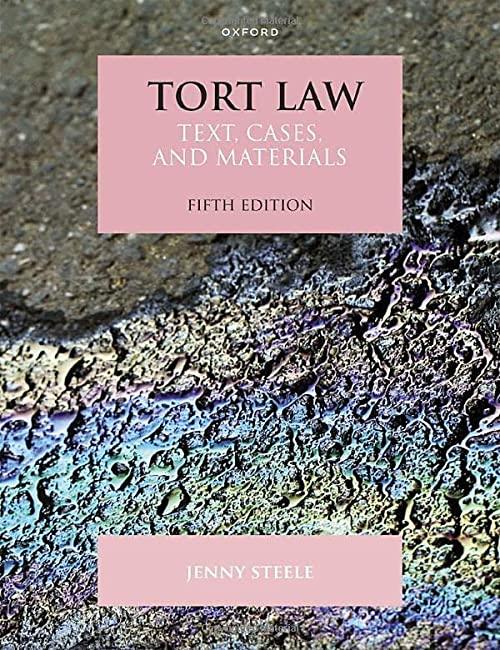Question
Read the 7-2 Business Scenarios and Case and Problem below and found in your MindTap course under the Chapter Review section. Draft your IRAC for
Read the 7-2 Business Scenarios and Case and Problem below and found in your MindTap course under the Chapter Review section. Draft your IRAC for this problem.
7-2.FairUse.Professor Wise is teaching a summer seminar in business torts at State University. Several times during the course, he makes copies of relevant sections from business law texts and distributes them to his students. Wise does not realize that the daughter of one of the textbook authors is a member of his seminar. She tells her father about Wise's copying activities, which have taken place without her father's or his publisher's permission. Her father sues Wise for copyright infringement. Wise claims protection under the fair use doctrine. Who will prevail? Explain. (SeeCopyrights.)
Please govern yourselves accordinly,
THE EXAMPLE OF WHAT IT SHOULD LOOK LIKE IS HERE (SAME FORMAT):
- 7-1.
Patent Infringement.John and Andrew Doney invented a hard-bearing device for balancing rotors. Although they obtained a patent for their invention from the U.S. Patent and Trademark Office, it was never used as an automobile wheel balancer. Some time later, Exetron Corp. produced an automobile wheel balancer that used a hard-bearing device similar to the Doneys' device. Given that the Doneys had not used their device for automobile wheel balancing, does Exetron's use of a similar device infringe on the Doneys' patent? (SeePatents.)
- (I)ssue: Patent Infringement-Does Exetron's production of an automobile wheel balancer that uses a hard-bearingng device similar to the device patented by John and Andrew Doney, infringe on the Doneys' patent, given the fact that Doneys had not used their device for automobile wheel balancing?
- (R)ule:Apatent is a grant from the government that gives an inventor the exclusive right to make, use, and sell an invention for a period of twenty years. Patents for designs, as opposed to inventions, are given for a fourteen-year period. The applicant must demonstrate to the satisfaction of the U.S. Patent and Trademark Office that the invention, discovery, process, or design is novel, useful, and not obvious in light of current technology.
- 7-2c-Patent Infringement:
If a firm makes, uses, or sells another's patented design, product, or process without the patent owner's permission, it commits the tort of patent infringement. Patent infringement may occur even though the patent owner has not put the patented product into commerce. Patent infringement may also occur even though not all features or parts of an invention are copied. (To infringe the patent on a process, however, all steps or their equivalent must be copied.)
- (A)nalysis/(A)pplication: Here, John and Andrew Doney invented a hard-bearing device for balancing rotors. The Doneys obtained a patent for their invention from the U.S. Patent and Trademark Office, although it was never used as an automobile wheel balancer. Some time later, Exetron Corp. produced an automobile wheel balancer that used a hard-bearing device similar to the Doneys' device. If a firm makes, uses, or sells another's patented design, product, or process without the patent owner's permission, it commits the tort of patent infringement. Patent infringement may occur even though the patent owner has not put the patented product into commerce. Patent infringement may also occur even though not all features or parts of an invention are copied. (To infringe the patent on a process, however, all steps or their equivalent must be copied.
- (C)onclusion/Decision: Yes, Exetron's use of a similar device does infringe on the Doneys' patent. If a firm makes, uses, or sells another's patented design, product, or process without the patent owner's permission, it commits the tort of patent infringement. Given that the Doneys had not used their device for automobile wheel balancing, patent infringement may occur even though the patent owner has not put the patented product into commerce. Patent infringement may also occur even though not all features or parts of an invention are copied.
- Note: (To infringe the patent on a process, however, all steps or their equivalent must be copied.
Step by Step Solution
There are 3 Steps involved in it
Step: 1

Get Instant Access to Expert-Tailored Solutions
See step-by-step solutions with expert insights and AI powered tools for academic success
Step: 2

Step: 3

Ace Your Homework with AI
Get the answers you need in no time with our AI-driven, step-by-step assistance
Get Started


